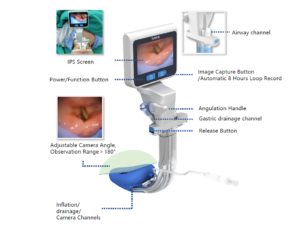What is a Laryngeal Mask?
A laryngeal mask is a small, flexible medical device that is used to maintain an open airway during medical procedures or surgeries. It is a type of airway management device that is inserted into the patient’s mouth and positioned over the opening of the larynx.
It is designed to provide an unobstructed passage for air to flow into the lungs, while also preventing the patient from inhaling any foreign objects or fluids. Laryngeal masks are commonly used as an alternative to endotracheal intubation, as they are less invasive and can be inserted more quickly, making them an essential tool for emergency medical situations.
The purpose of this article is not to discuss how laryngeal masks work; Instead, we will be discussing common mistakes made when using laryngeal masks, why those mistakes can be dangerous for patients, and how video laryngeal masks function to negate these dangers.
The Benefits of Laryngeal Masks
Laryngeal masks are a type of airway management device that can be used in place of an endotracheal tube (ETT). They are designed to allow oxygen to flow into the lungs and carbon dioxide to exit, while also providing some protection against aspiration (the inhalation of stomach contents into the lungs).
The main benefit of laryngeal masks is their ability to reduce the risk of aspiration, which occurs when food or liquid enters the lungs rather than being swallowed. This can lead to pneumonia or other complications if not treated promptly.
Laryngeal masks’ inflatable cuff also provides a good seal around your throat, so there’s less chance that you’ll breathe in any fluid during surgery. If you do inhale something accidentally, it won’t go into your lungs as easily as it would with another type of masking device like an endotracheal tube.
What is Mispositioning?
Mispositioning refers to the incorrect placement of a laryngeal mask airway (LMA). This can occur during insertion, or after it has been placed and is likely in 50-60% of LMA placement cases with no visual aid.
Signs of Mispositioning
* Breathing difficulty
* Aspiration
* Damage to the vocal cords
The Impact of Mispositioning
The most common complications associated with mispositioned laryngeal masks include:

* Airway obstruction and hypoxia
* Hemorrhage or bleeding
* Cuff leak (if the cuff is not inflated properly)
Preventing Mispositioning
* Training
* Sizing
* Monitoring
The Role of Video LMAs in the Medical Industry
A video laryngeal mask airway (video LMA) device offers many benefits compared to traditional LMA devices. One of the primary advantages is that it allows for continuous visualization of the airway throughout the procedure. This can help to prevent mispositioning and ensure that the device is functioning correctly.
Video LMA devices have been shown to improve patient outcomes by reducing the risk of complications such as aspiration and airway obstruction. Furthermore, they can increase the accuracy of airway placement and reduce the time required for the procedure, making them a valuable addition to emergency medical situations. Overall, video LMA devices offer enhanced safety, efficiency, and patient outcomes in airway management during medical procedures. Geo-Med, LLC is proud to be the sole distributor of Magill Medical’s SafeLM® Video LMA in the government market space.
